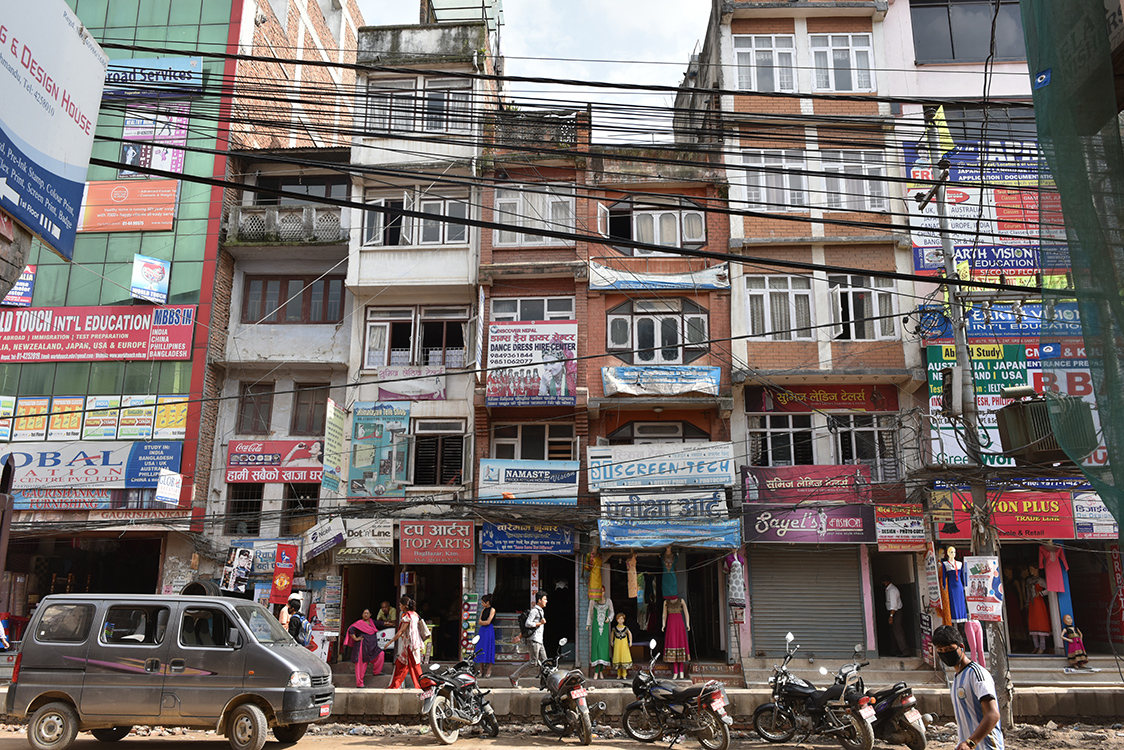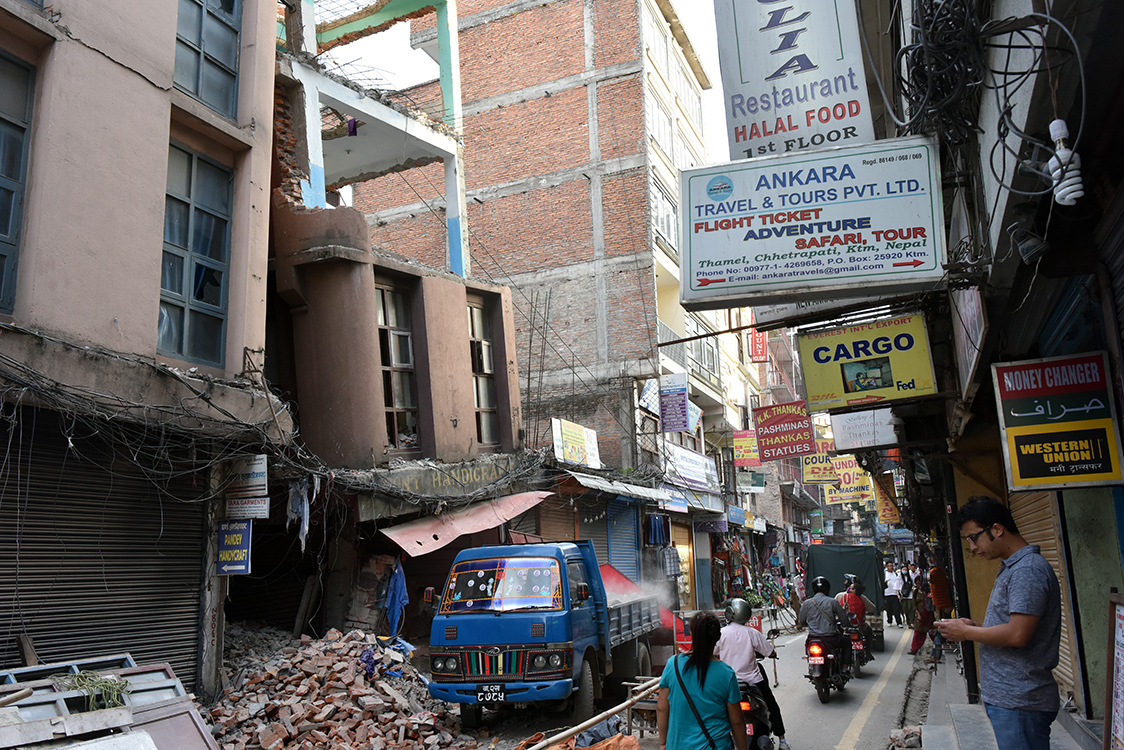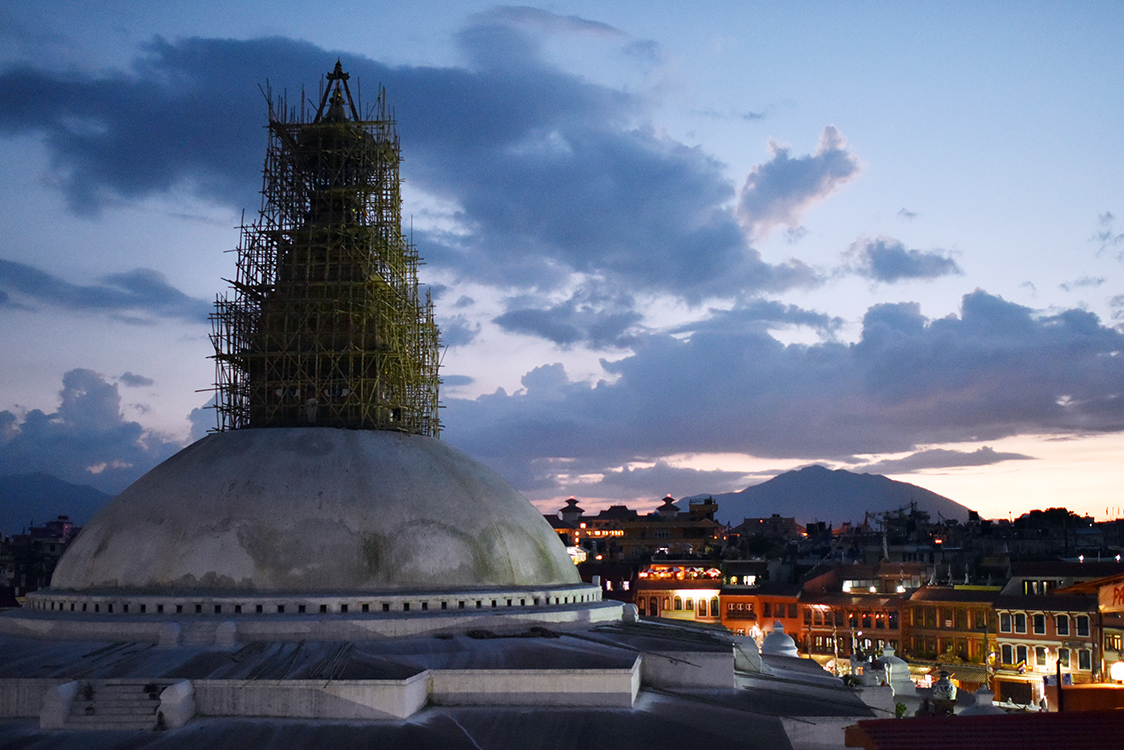Kathmandu post Earthquake: Same same, but different…
On Friday June 12, around 9pm we landed on the single run-way of Nepal’s single international airport in Kathmandu, passing through a few thunderstorms on our descent. There are no fancy airwalks at this airport, only air-buses to transport passengers a whole 15 yards between the plane and the terminal.
It appeared we were one of the last flights for the day, which is to say that our passengers were the only non-airport personnel in the tiny brick airport, making the visa-on-demand and immigration lines a pretty quick process. A fresh wave of satisfaction came over me as I greeted the immigration agent in Nepali and he smiled in pleased surprise. The baggage lounge was cluttered with canvas wrapped parcels labeled “Earthquake relief” piled against walls and pillars alike. A couple dozen bags circled on the squeaky conveyor belt. On my way through customs, an agent asked me about my four bottles of duty-free wine:
“Sister, the limit is only 2 bottles you know?”
I responded, in Nepali, “Oh, I’m sorry brother, I didn’t know, but these are gifts for my friends here.”
“Oh ok, that’s fine sister,” he replied with a hand gesture and a grin. “Go ahead.”
For all the trouble a tiny airport brings, it also has certain advantages.
I peered out the window as a taxi took me to my room, anxious to see the extent of damage for myself. Nightfall limited the details, but from what I could see – most everything looked normal. Whole blocks of buildings were still standing; in fact, if I hadn’t known to look that night I may not have noticed anything wrong. A first time visitor, however, may have seen a lot awry. Kathmandu has been a torn up city for some time now. The recent civil war caused (mostly) indirect damage by spurring rapid internal migration: a large influx of rural residents relocated to Kathmandu Valley in order to escape pressure from the rural-based insurgents. Consequently the city rapidly expanded and burst at the edges and infrastructure systems were stretched beyond their capacity. The broken government has struggled to update infrastructure ever since, leaving water ways to appear as combined sewage-garbage dumps, and the air dense with vehicle and generator-produced smog. In recent years they have been widening the streets, tearing half-way through buildings to clear room, and leaving many streets a muddy mess with piles of sidewalk bricks strewn about. This alone gives the city a bit of a war-stricken appearance from the outside; consequently the sight of such things from my taxi window was in no way surprising. What was surprising was needing the earthquake rubble to be pointed out to me, almost as if the earthquake had come down like lightning, striking buildings here and there at random.




To clearly restate this, Kathmandu was NOT FLATTENED by either the April 25th or May 12th earthquakes – far from it – as the media portrayal of the disaster had lead many in the global community to believe. I had had some knowledge of this before arriving, as I had maintained extensive contact with many of my Kathmandu-based friends and they had told me that large swaths of the city did not appear damaged at all. But even knowing this, I was surprised at how little seemed to have changed through the central city. Now, two months after the April Earthquake, life in Kathmandu appears mostly normal – only with a building crumbling here or there and the occasional pile of sorted rubble. Shops are open, the streets are jammed with traffic, uniformed children walk to school each morning, the air smells of it’s usual blend of incense, spices and petrol. There’s something reassuring about this – about the ability for people to pick themselves up after a traumatic experience and continue with their lives – but there is also something deceiving.
It wasn’t until my fifth day that I felt my first aftershock – a magnitude 5.2 that jolted me awake at 6 in the morning. It only lasted a couple seconds. Being from California, it didn’t strike immediate panic but instead a strange sense of readiness. I mean, I’d been expecting this. But I understood the panicked cries that echoed through the neighborhood from those who had experienced the big quake followed by the terror of continuous aftershocks. The aftershocks became such a frequent part of their post-earthquake reality that many locals play guess-the-magnitude, post things like “did you feel it?” on social media and then – look it up on a new “aftershock-magnitude” app that was developed for their smart phones. The initial regularity of the aftershocks kept many sleeping in tents outside of their homes for those first two months. So much so that a large portion of the initial tents were for this purpose – for those who still had their homes but were too scared to sleep in them – not just for those who had become truly homeless.
To be certain, a large number of tent camps remain sprinkled throughout the open spaces of the city. But compared to the images and stories of “tent-cities” in Haiti and other places, the tent camps of Kathmandu are far less overwhelming. The accommodations are quite modest, but there’s often quite a bit of space between them; that is to say the fields don’t look cramped. How can so many be homeless and yet the tent cities be (by comparison) relatively minimal? It turns out the earthquake had an inverse effect of the civil war: it sparked a rapid out-migration of residents back to their village roots. Something like 800,000 people left the valley over the week following the first quake.

In addition to the tent camps there are a lot of individual make-shift tents tucked away on empty lots or yards in the middle of neighborhoods. These were mostly set up as safeguards by cautious individuals who either had minorly cracked houses or were simply kept fearful by the aftershocks. As the aftershocks die down and the monsoon rains ramp up, most people have returned to their houses,cracks and all, and these tents are gradually disappearing.
To me, the true deception of the appearance of life-as-usual comes from the less dramatic damages: the cracks. Both the hidden ones, and the visible ones now being ignored as the general sense of danger loses it’s urgency in the community psych and as the discomforts of monsoon make tent life less enjoyable. In the past two months the government has developed a “sticker” system, sending out engineers to assess the level of damage to public properties and attaching a corresponding green (safe for use), yellow (enter with caution) or red (dangerous – do not enter) sign to the doors and windows. Trouble is, the majority of the building stock isn’t public; I’ve seen very few of these stickers across the city. Clearly a full assessment of the building stock presents a daunting task, but it begs the question: how many structures are unsafe for future earthquakes, despite outward appearances? Quakes that may come in another year, or not for another ten? Monsoon season is non-construction season (it really does rain too much to run an effective construction site; when it rains, it pours buckets for a few hours at a time), so most people with cracked houses will occupy them through the season. Once monsoon lets up I’ll be curious to see who actually rebuilds / retrofits their cracked homes, and how the government will incentivize it, if at all.


In general, it’s seldom all or nothing in this world. The initial media portrayal of the earthquake lead us to believe Kathmandu was completely flattened. Not true. Then they said that all the concrete buildings survived but all of the old “traditional” brick ones did not. Again, not true. (I’ve seen both concrete buildings down, and traditional buildings still up.) And the media told us that Nepal had lost all of it’s heritage sites. Not true. Yes, a large portion of the historic structures have fallen to rubble, but not all. Quite notably Pashupatinath, the temple complex considered the guardian deity of Nepal, did not. Nor did it during the last major earthquake in the 1930’s – but the majority of temples that fell in April did. In the face of such destruction what did the Nepali people do then? They rebuilt their temples – and they will do it again.

This is a snapshot of a city transitioning from the relief phase to the recovery phase after a major disaster. What I hope this story begins to convey: while Kathmandu certainly suffered, it could have been much worse. The story left untold: what’s happening in the villages.


